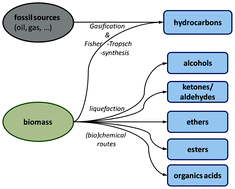From the test-tube to the test-engine: assessing the suitability of prospective liquid biofuel compounds†
Abstract
In the recent years, research efforts for the exploitation of biomass for the production of alternative

* Corresponding authors
a
Institute of Sustainable and Environmental Chemistry, Technische Universität Braunschweig, Hagenring 30, 38106 Braunschweig, Germany
E-mail:
falk.harnisch@ufz.de
Fax: 0341 235 1351
Tel: 0341 235 1337
b Institute of Internal Combustion Engines, Technische Universität Braunschweig, Langer Kamp 6, 38106, Braunschweig, Germany
c Department of Environmental Microbiology, UFZ-Helmholtz Centre for Environmental Research, Permoserstrasse 15, 04318, Leipzig, Germany
In the recent years, research efforts for the exploitation of biomass for the production of alternative

 Please wait while we load your content...
Something went wrong. Try again?
Please wait while we load your content...
Something went wrong. Try again?
F. Harnisch, I. Blei, T. R. D. Santos, M. Möller, P. Nilges, P. Eilts and U. Schröder, RSC Adv., 2013, 3, 9594 DOI: 10.1039/C3RA40354H
To request permission to reproduce material from this article, please go to the Copyright Clearance Center request page.
If you are an author contributing to an RSC publication, you do not need to request permission provided correct acknowledgement is given.
If you are the author of this article, you do not need to request permission to reproduce figures and diagrams provided correct acknowledgement is given. If you want to reproduce the whole article in a third-party publication (excluding your thesis/dissertation for which permission is not required) please go to the Copyright Clearance Center request page.
Read more about how to correctly acknowledge RSC content.
 Fetching data from CrossRef.
Fetching data from CrossRef.
This may take some time to load.
Loading related content
